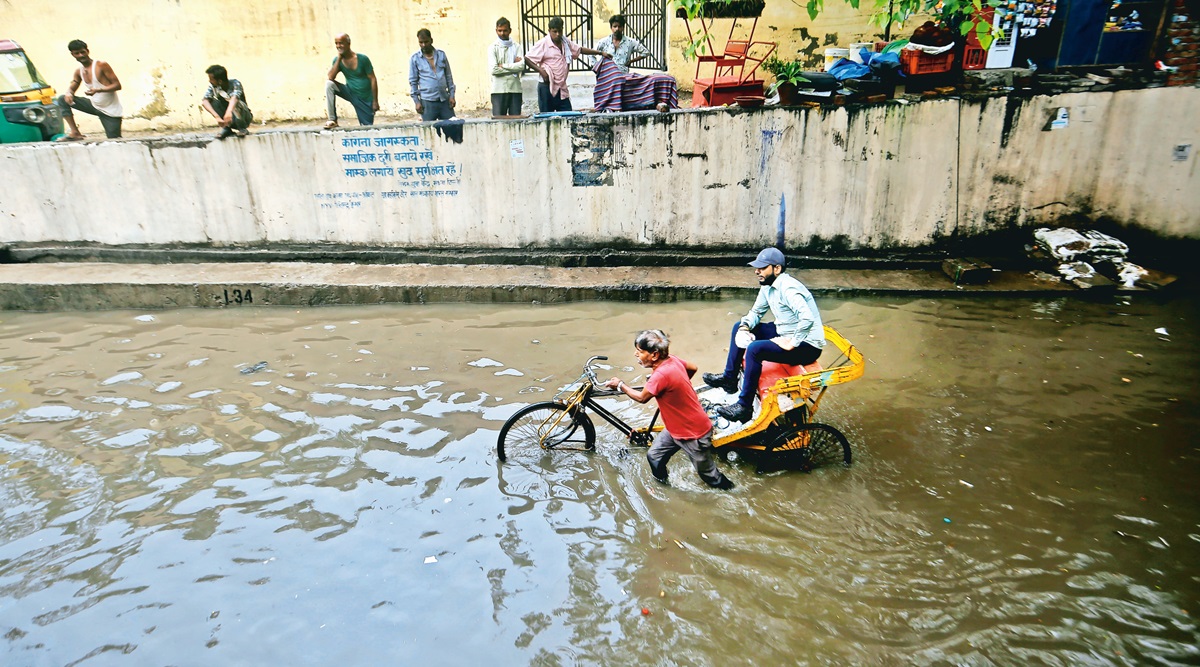 Several areas saw waterlogging after heavy rainfall in the capital. (Photo: Praveen Khanna)
Several areas saw waterlogging after heavy rainfall in the capital. (Photo: Praveen Khanna) Even as several areas in Delhi grapple with waterlogging due to heavy rainfall, the Public Works Department (PWD) has implemented temporary as well as permanent solutions at seven particularly vulnerable locations — Minto Bridge, Pul Prahladpur underpass, Zakhira flyover, Loni Road golchakkar, Jahangirpuri Metro station road, Karala Kanjhawala road, and IP Estate, opposite the WHO Building — to ensure no accidents take place.
For the first time in years, Minto Bridge, which experiences waterlogging every monsoon, has seen much less water collecting than usual after an alternate route was created for rainwater discharge. Going forward, officials hope to implement such solutions at the other critical points too.
PWD Secretary Dilraj Kaur told reporters on Monday, “Waterlogging is a multi-faceted problem; in some areas such as Pul Prahladpur underpass, the topography is such that the water accumulates there. Secondly, drains that were built perhaps in the British era do not have the capacity as population has increased.”
She added that unplanned development has only exacerbated the problems. Further, the pattern of rainfall has changed in the last few years. “Our solutions have to be retrofitted. We cannot change the situation overnight. I have full faith that the department will leave no stone unturned to provide appropriate solutions… Minto bridge is the perfect example of that,” said Kaur.
A senior PWD official added: “The list of critical locations was made based on the maximum number of waterlogging complaints from last year. By next year, we would have implemented permanent solutions. For the time being, we are taking temporary measures in these areas.”
Problems & solutions
Minto Bridge: The area had a deep barrel drain, built during the British era, and both sewage water and drain water would flow into the same lines and end up in the Yamuna. In the last few months, officials laid a new pipeline for pressurised flow further ahead on Minto road.
Pul Prahladpur underpass: Seven CCTV cameras and seven temporary pumps, with a capacity of over 400 HP, have been installed. The permanent solution is to install an underground sump with enhanced capacity, said officials.
Zakhira Flyover: The area under the flyover, which gets heavily waterlogged due to rainwater from the railway tracks and floating waste from nearby jhuggis, has diesel pumps ready in case of power failure. A permanent solution is re-routing or constructing stormwater drains under the flyover.
Loni Road golchakkar: A naturally low-lying area like underpasses. There is also back-flow from an I&FC drain. A permanent solution for this area is laying an additional pipeline and enhancing the capacity of electrical pumps.
Jahangirpuri Metro station road: The area gets waterlogged due to mixed discharge from populated colonies nearby. It also has a lot of industrial waste, and polythene bags from the mandi. PWD officials said two old storm water drains would have to be remodelled.
Karala Kanjhawala road: This road, too, has drains with lower capacity since they were built years ago. Besides regular coordination with traffic police and monitoring, trolley mounted pumps have been deployed at three locations. A permanent solution, however, is to remodel the drain with a sump well and pumping system.
IP Estate: Complaints of waterlogging have been pouring in from IP Estate on Ring Road, opposite the WHO building, in the last few years. Officials said a sump with capacity of approximately 1.5 lakh litres and pumps of suitable discharge will be set up by the department by monsoon 2022.
For the time being, additional pumps have been installed at many locations. A few areas, including these seven points, are being monitored at the PWD control room through the day. Live footage from critical points is available in the control room and on phones of field staff.
- The Indian Express website has been rated GREEN for its credibility and trustworthiness by Newsguard, a global service that rates news sources for their journalistic standards.

